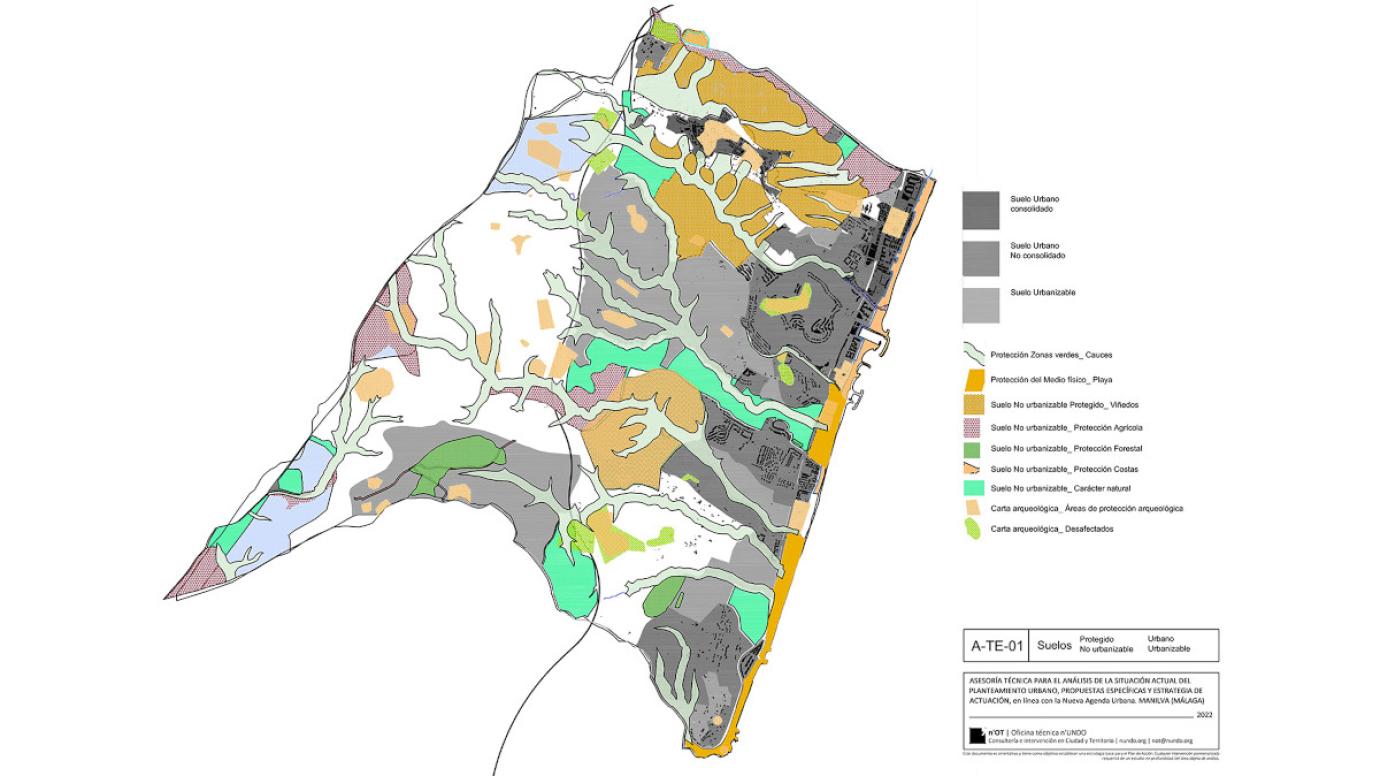Manilva: a small coastal city turns green
Responsible urban planning for climate resilience.
- Pays:
-
 Spain
Spain
- Type of project :
- Governance
- Size of city/region:
- Below 30 000 inhabitants

Key facts
Architecture studios: n'UNDO
Main sponsor: Manilva City Council
Year completed: 2022
Prizes: 2022 Spanish National Urbanism Award
City / regional background
Manilva is a coastal municipality in the province of Málaga, Andalusia. Its location, wine culture, and heritage make it a tourist destination. It has been one of the fastest developing municipalities on the Costa del Sol in the past decade, with its population nearly tripling. In 2019, more than a third of its residents were foreigners, primarily from the United Kingdom. Although an economic engine, tourism increases traffic and pollution and pressures municipal services and supplies.
In recent years, the municipality has been updating its urban and territorial planning to align with regional, national and international strategies addressing the climate crisis. The local urban agenda and its related action plan strongly emphasise sustainability, renaturation, decarbonisation and climate resilience across policy areas.
In line with these objectives, the Municipal Urban Planning Office commissioned the technical office n'UNDO to conduct a study and propose a strategy for improving and regenerating Manilva’s urban and surrounding environment. The n'UNDO methodology is based on the principles of minimum intervention (“Do not do”, “Undo”, and “Redo”) for a maximum impact.
Solution
The technical assistance resulted in an urban planning decision-making tool: the “#Manilva Plan n’2030”. It offers concrete proposals and strategies for the sustainable development of Manilva in the short, medium and long term, allowing flexible execution, feedback and adaptation to changes.
This plan includes 212 specific and independent actions, coordinated through 3 strategies:
- Manilva, natural and cultural
- Manilva, connected and accessible
- Manilva, alive all year
The proposals can be executed independently and without a pre-established order to ensure greater quality, control, and readjustment over time.
Some examples include the rehabilitation of abandoned buildings for housing, reducing car traffic in the urban centre, green walks to connect peri-urban areas with the centre, dismantling 7.5 km of highway going through the city centre, parking areas within 200 metres of the coastline, and establishing a permanent citizen participation platform.
In the analysis and proposal phase, Manilva City Council included various agents from public administration, elected representatives, and civil society (residents, businesses, heritage organisations). Those diverse perspectives created a fine-grained picture of the area and contributed to concrete proposals towards a sustainable urban model in the short-, medium- and long term.
Criteria for high-quality (context, sense of place, diversity, beauty)
- The analysis was carried out at different scales (territorial, municipal, street) to make visible and connect the various realities that coexist in the territorial and urban complexity and to involve all agents linked to the process. It favours the inclusion of different viewpoints ranging from subjective perceptions to more technical approaches.
- The analysis involved a review of cultural, heritage and ecological landscapes, territorial sustainability, urban sprawl and diversity. It also examined the mountain-coast connection and the dual impact of tourism.
- The methodology is characterised by its adaptability, holistic process, and participatory nature, with a continuous dialogue in all phases tailored to specific cases with flexible timelines. The result is an accessible and practical format with digital support to facilitate the management of the plan and the monitoring of the different phases: I. Analysis and diagnosis, II. Proposals and Strategy, III. Implementation and, IV. Evaluation.
Governance and management
This work has been promoted and supervised by the technical and legal unit of the Urban Planning Department of the City Council of Manilva.
To develop Plan n', the number of staff and the technical profiles are adapted to the size of the area and local conditions. In Manilva, only Phase I (Analysis and diagnosis) and II (Proposals and strategy definition) of Plan n’ were developed, involving a team manager and two urban planners, supported by other profiles for specific areas as environmental sciences and ecology.
Budget and financing
The budget for the technical assistance for the preparatory works of the Local Urban Agenda and its Action Plan was €14 500 (Phase 1 and 2), funded by the Municipal Urban Planning Office of Manilva.
Transferable ideas
The Plan n'UNDO methodology is replicable in various contexts and scales.
Tips from the city:
- Secure political and technical commitment from the outset. Prioritise process over results.
- Have a clear idea of the local needs in relation to the 2030 Agenda for Sustainable Development.
Start with the first two stages of the methodology, which require a minimum of the resources to obtain a perspective of the possibilities and strategies that can be applied in your territory.


